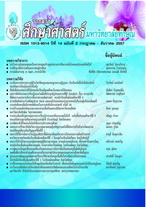ผลการใช้วิธีการจัดการเรียนรู้แบบซิปปาที่มีต่อผลสัมฤทธิ์ทางการเรียนและความคิดสร้างสรรค์ทางวิทยาศาสตร์ ของนักเรียนชั้นมัธยมศึกษาปีที่ 1 ในกลุ่มโรงเรียนไผ่ศรีทอง จังหวัดสิงห์บุรี
Main Article Content
บทคัดย่อ
บทคัดย่อ
การวิจัยในครั้งนี้มีวัตถุประสงค์เพื่อ (1) เปรียบเทียบผลสัมฤทธิ์ทางการเรียนของนักเรียนชั้นมัธยมศึกษาปีที่ 1 โรงเรียนทองเอนวิทยา จังหวัดสิงห์บุรี ที่เรียนโดยวิธีการจัดการเรียนรู้แบบซิปปาและที่เรียนตามปกติหลังเรียน (2) เปรียบเทียบผลสัมฤทธิ์ทางการเรียนของนักเรียนดังกล่าว ที่เรียนโดยวิธีการจัดการเรียนรู้แบบซิปปาก่อนเรียนและหลังเรียน (3) เปรียบเทียบความคิดสร้างสรรค์ทางวิทยาศาสตร์ของนักเรียนดังกล่าว ที่เรียนโดยวิธีการจัดการเรียนรู้แบบซิปปาและที่เรียนตามปกติหลังเรียน และ (4) เปรียบเทียบความคิดสร้างสรรค์ทางวิทยาศาสตร์ของนักเรียนดังกล่าวที่เรียนโดยวิธีการจัดการเรียนรู้แบบซิปปาก่อนเรียนและหลังเรียน
กลุ่มตัวอย่างที่ใช้ในการวิจัยเป็นนักเรียนชั้นมัธยมศึกษาปีที่ 1 โรงเรียนทองเอนวิทยา ภาคเรียนที่ 1 ปีการศึกษา 2556 จำนวน 2 ห้องเรียน ห้องเรียนละ 20 คน ได้มาโดยการสุ่มแบบกลุ่ม เครื่องมือที่ใช้ในการวิจัย ได้แก่ แผนการจัดการเรียนรู้แบบซิปปา แผนการจัดการเรียนรู้แบบปกติ แบบทดสอบวัดผลสัมฤทธิ์ทางการเรียน แบบทดสอบวัดความคิดสร้างสรรค์ทางวิทยาศาสตร์ ที่ผู้วิจัยสร้างขึ้น สถิติที่ใช้ในการวิเคราะห์ข้อมูล ได้แก่ ค่าเฉลี่ย ส่วนเบี่ยงเบนมาตรฐาน และการทดสอบค่าที
ผลการวิจัยพบว่า (1) ผลสัมฤทธิ์ทางการเรียนหลังเรียนของนักเรียนชั้นมัธยมศึกษาปีที่ 1 โรงเรียนทองเอนวิทยา จังหวัดสิงห์บุรี ที่เรียนโดยวิธีการจัดการเรียนรู้แบบซิปปาสูงกว่านักเรียนที่เรียนตามปกติอย่างมีนัยสำคัญทางสถิติที่ระดับ .01 (2) ผลสัมฤทธิ์ทางการเรียนของนักเรียนดังกล่าว ที่เรียนโดยวิธีการจัดการเรียนรู้แบบซิปปาหลังเรียนสูงกว่าก่อนเรียนอย่างมีนัยสำคัญทางสถิติที่ระดับ .01 (3) ความคิดสร้างสรรค์ทางวิทยาศาสตร์หลังเรียนของนักเรียนดังกล่าวที่เรียนโดยวิธีการจัดการเรียนรู้แบบซิปปาสูงกว่านักเรียนที่เรียนตามปกติอย่างมีนัยสำคัญทางสถิติที่ระดับ .01 และ (4) ความคิดสร้างสรรค์ทางวิทยาศาสตร์ของนักเรียนดังกล่าวเรียนโดยวิธีการจัดการเรียนรู้แบบซิปปาหลังเรียนสูงกว่าก่อนเรียนอย่างมีนัยสำคัญทางสถิติที่ระดับ .01
Achievement and Creative Thinking in Science of Mathayom Suksa I Students of Phai Si Thong School Cluster in Sing Buri Province
The purposes of this study were to (1) compare learning achievement after learning of the Mathayom Suksa I students of Thong-En Witya school in Sing Buri Province learned by using the CIPPA model learning management and those learned by using traditional approach; (2) compare learning achievement of the students learned by using the CIPPA model learning management before and after learning; (3) compare creative thinking in science after learning of the students learned by using the CIPPA model learning management and those learned by using traditional approach; and (4) compare creative thinking in science of the students learned by using the CIPPA model learning management before and after learning.
The sample consisted of two classrooms of 20 Mathayom Suksa I students of Thong-En Witya school in Phai Si Thong School Cluster in Sing Buri province, obtained by cluster random sampling. Research instruments included lesson plans using the CIPPA model learning management, lesson plans using traditional approach, the science learning achievement test and the scientific creativity test. Data were analyzed by using the mean, standard deviation and t-test.
The research findings showed that (1) the learning achievement after learning of the Mathayom Suksa I students of Thong-En Witya School learned by using the CIPPA model learning management was significantly higher than those learned by using traditional approach at the .01 level; (2) the learning achievement after learning of the students learned by using the CIPPA model learning management was significantly higher than that of before at the .01 level; (3) the creative thinking in science after learning of the students learned by using the CIPPA model learning management was significantly higher than those learned by using traditional approach at the .01 level; and (4) the creative thinking in science after learning of the students learned by using the CIPPA model learning management was significantly higher than that of before at the .01 level.
Article Details
ในกรณีที่กองบรรณาธิการ หรือผู้เชี่ยวชาญ ซึ่งได้รับเชิญให้เป็นผู้ตรวจบทความวิจัย หรือ บทความทางวิชาการมีความเห็นว่าควรแก้ไขความบกพร่อง ทางกองบรรณาธิการจะส่งต้นฉบับให้ ผู้เขียนพิจารณาจัดการแก้ไขให้เหมาะสมก่อนที่จะลงพิมพ์ ทั้งนี้ กองบรรณาธิการจะยึดถือความคิด เห็นของผู้เชี่ยวชาญเป็นเกณฑ์

